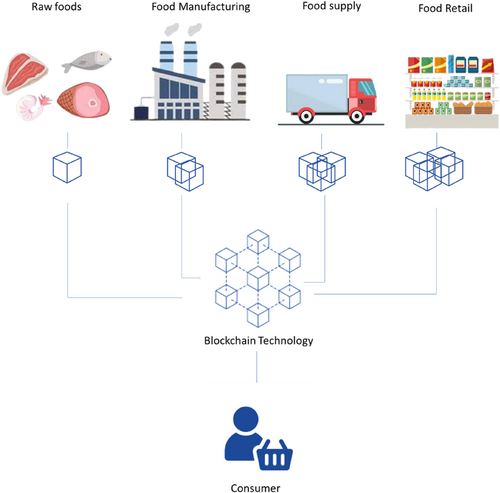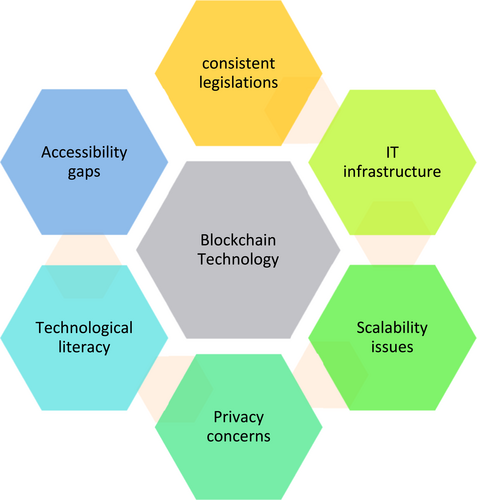Blockchain technology has garnered considerable attention across multiple sectors due to its potential to enhance security, efficiency, and transparency (Shakila et al., 2024). Security concerns have been a central focus of research, with studies emphasizing the necessity of systematically identifying and addressing vulnerabilities within blockchain systems (Li & Chen, 2022). Beyond security, blockchain has been applied in diverse domains including healthcare, finance, and supply chain management demonstrating its versatility and adaptability (Zhuang et al., 2020; Bauvars, 2021).
The integration of blockchain with Internet of Things (IoT) systems has also emerged as a significant area of interest. Research in this domain has explored the challenges, opportunities, and strategic directions for leveraging blockchain in IoT applications (Abdelmaboud et al., 2022). Moreover, blockchain has been recognized for its potential to transform industries such as e-commerce, oil and gas, and small- and medium-sized enterprises, offering benefits such as enhanced data security, operational efficiency, and regulatory compliance (Lu et al., 2019; Wang, 2022a; Song et al., 2022).
Read More: Harnessing Biological Agents and Synthetic Chemistries Together
In addition, studies have examined the role of blockchain in improving audit processes, financial transactions, and decision-making, highlighting its capacity to streamline operations and strengthen accountability (Gao & Lin, 2023; Coyne & McMickle, 2017; Xiao et al., 2023). The evolution of blockchain technology has also prompted discussions on governance, trust, and control, underscoring the need to better understand its institutional implications (Meijer & Ubacht, 2018).
As blockchain continues to advance, researchers are exploring emerging frontiers such as quantum-secured blockchains and vulnerabilities in smart contract security, reflecting a growing focus on enhancing system robustness and resilience (TAŞ, 2023; Kiktenko et al., 2018). Overall, the research landscape surrounding blockchain is diverse and dynamic, reflecting ongoing efforts to fully harness the technology’s potential across multiple domains.
Blockchain for Food Safety and Traceability
Blockchain technology has attracted significant attention in the food industry due to its potential to enhance transparency and traceability within supply chains. Several studies have highlighted both the benefits and challenges of implementing blockchain in the food sector. Kamilaris et al. (2019) emphasized the promise of blockchain in creating transparent food supply chains while acknowledging barriers that hinder widespread adoption. Duan et al. (2020) further note that blockchain can improve food traceability, information transparency, and recall efficiency, particularly when integrated with the Internet of Things (IoT).
Beyond traceability, blockchain applications in the food industry also aim to enhance food reliability and support sustainable business operations (Jang et al., 2023). Katsikouli et al. (2020) and Antonucci et al. (2019) discuss how blockchain can help meet industry requirements, including improved supply chain management and operational transparency. Dehghani et al. (2021) note that blockchain was initially introduced in the food sector primarily to address safety concerns, while Hasan and Habib (2022) highlight the combined potential of blockchain and IoT to create a more trustworthy and sustainable agri-food system.
Blockchain’s promise extends to the broader food-catering sector, where it can enhance organizational capabilities and streamline supply chain processes (Sharma, Sharma, et al., 2023; Katsikouli et al., 2020). Research has also explored its role in creating sustainable competitive advantages (Rezaei et al., 2023) and preventing fraud in food safety (Wang, 2022b). Collectively, these studies underscore blockchain’s importance in ensuring food safety, reducing fraud, and optimizing supply chain management.
Consumer perspectives further highlight blockchain’s relevance. Lin et al. (2021) examined intentions to adopt blockchain-based traceability for organic food products, reflecting increasing interest in technology-driven food safety solutions. Hoang et al. (2023) investigated how blockchain adoption by retailers in developing countries can influence brand communication and customer experience, illustrating its broader implications in retail.
Additionally, blockchain facilitates immutable data storage, reduces food loss, and enhances operational transparency (Kumar et al., 2022), findings corroborated by Mukherjee et al. (2023), who demonstrated improvements in distribution efficiency, agility, and information transparency in food services.
Overall, the literature highlights blockchain’s transformative potential in the food retail sector, from improving supply chain transparency and traceability to strengthening consumer trust and operational efficiency (Sridhar et al., 2023; Kolikipogu et al., 2025). By addressing existing challenges and leveraging its benefits, blockchain technology can help the food industry develop more resilient, consumer-centric, and sustainable supply chains.

Blockchain for Supply Chain Management
Blockchain technology has emerged as a transformative tool in supply chain management, offering key benefits such as transparency, traceability, and security (Saberi et al., 2018). Research indicates that blockchain can enhance supply chain sustainability by improving traceability and supporting more informed decision-making processes (Park & Li, 2021). By providing a secure and reliable platform for information exchange, blockchain addresses trust issues inherent in logistics and supply chain networks (Liu & Zhang, 2021), thereby supporting more efficient and resilient operations (Hasan & Habib, 2022).
The adoption of blockchain in supply chains has been associated with reduced transaction times and improved operational efficiency (Sharma, Bhatia, et al., 2023). Furthermore, blockchain enables new opportunities in supply chain finance, promoting sustainable growth through its decentralized and immutable nature (Z. Liu, 2021; Xie & Li, 2021). It also allows manufacturers to implement deep-tier financing strategies, enhancing supply chain resilience and visibility (Li & Chen, 2022). Specific blockchain-based systems, such as AgriBlockIoT, have been developed to support agri-food supply chains by ensuring uninterrupted data flow across the entire network (Kolodiy et al., 2022).
Despite its potential, blockchain adoption can disrupt existing supply chain practices, and several challenges must be addressed for successful integration (Wang et al., 2019). In the food sector, blockchain has received particular attention for its ability to improve transparency and traceability. Kamilaris et al. (2019) highlighted blockchain’s promise in creating transparent food supply chains while noting barriers to widespread adoption. Feng et al. (2020) similarly identified benefits and challenges, emphasizing the limited understanding of blockchain’s role in enhancing food traceability.
Further studies underscore blockchain’s positive impact on food supply chain management. Duan et al. (2020) and Katsikouli et al. (2020) demonstrate its potential to improve traceability and operational efficiency, while Gulen and Karaagac (2024) reviewed common blockchain platforms for managing agricultural supply chains, highlighting their strengths in precision agriculture. Kayikci et al. (2020) proposed a comprehensive framework for blockchain implementation in food supply chains, considering people, processes, performance, and technology. Vu et al. (2021) emphasized the need for a structured, sector-specific approach to blockchain adoption, given the scarcity of targeted studies.
Gonczol et al. (2020) explored multiple use cases of blockchain in food supply chains, detailing integration across various agents and stages, and Sharma, Sharma, et al. (2023) further demonstrated how blockchain adoption enhances performance and drives digitalization in agri-food supply chains. Collectively, these studies highlight blockchain’s potential to revolutionize food supply chains by improving management, transparency, traceability, and food safety (Kayikci et al., 2020; Singh et al., 2023).

Blockchain for Food Product Authentication
Blockchain technology has emerged as a promising solution for enhancing food product authentication within supply chains. By leveraging blockchain, businesses can ensure the reliability and integrity of traceability data, thereby strengthening customer trust and protecting brand reputation while reducing risks associated with counterfeit products (Deng & Feng, 2020; Sharma, Bhatia, et al., 2023; Singh et al., 2023). Additionally, blockchain improves transparency across the entire food production process—from raw materials to end consumers enhancing overall supply chain visibility (Hamidi et al., 2021).
Research highlights blockchain’s potential to address specific challenges in the food industry, such as the lack of traceability and authenticity in low-cost products, through the use of non-fungible tokens (NFTs) (Hawashin et al., 2023). The integration of blockchain with Internet of Things (IoT) devices further enables comprehensive traceability systems for perishable goods, ensuring end-to-end transparency throughout the supply chain (Hasan et al., 2022; Hasan et al., 2023). Blockchain-based solutions such as AgriBlockIoT offer decentralized traceability for agri-food supply chains, seamlessly incorporating IoT devices to monitor and record digital data across all stages (Caro et al., 2018).
While blockchain provides a tamper-proof audit trail for supply chain events and product data, challenges remain regarding trust management and adoption (Malik et al., 2019). However, combining blockchain with IoT enhances trust across supply chains, mitigates counterfeiting risks, and ensures secure transactions. By utilizing decentralized data management and consensus mechanisms, blockchain enables efficient tracking and tracing of food products, promoting transparency, reliability, and authenticity across the supply chain (Tsang et al., 2019).
Challenges for Blockchain in the Food Sector
Despite its potential to enhance transparency and efficiency, the adoption of blockchain technology in the food sector faces several significant challenges (Figure 3). These include inconsistent regulations, accessibility gaps, limited technological literacy, privacy concerns, the need for robust IT infrastructure, scalability issues, internal governance complexities, and the risk of human error (Krzyzanowski Guerra & Boys, 2021). Such obstacles hinder widespread adoption among farmers and supply chain stakeholders (Kamilaris et al., 2019). Additionally, smallholder farmers often face difficulties in recording transactions and participating effectively in blockchain-based ecosystems for food and agriculture (Xiong et al., 2020).
The implementation of blockchain in agri-food production also encounters challenges and opportunities that are context-specific. For instance, T. T. Vu and Trinh (2021) highlight strengths and weaknesses in applying blockchain within the Vietnamese agricultural industry. Beyond technical considerations, environmental, social, and organizational factors play a critical role in shaping the successful integration of blockchain technology (Wang et al., 2019; Feng et al., 2020).
Moreover, blockchain adoption is often limited by a lack of in-depth understanding of the technology, challenges in managing raw data, difficulties in stakeholder engagement, and gaps in regulatory frameworks (Duan et al., 2020). Addressing these challenges is essential to unlocking blockchain’s full potential in creating transparent, efficient, and resilient food supply chains.

Regulatory Considerations
Blockchain technology has the potential to transform multiple sectors, including agriculture, financial services, accounting, and healthcare. However, its adoption requires careful attention to regulatory frameworks to ensure compliance and successful implementation (Yeoh, 2017; Han & Park, 2022; Politou et al., 2021). The regulatory landscape for blockchain is complex, encompassing data protection, financial regulations, and broader legal considerations (Han & Park, 2022; Finck, 2018; Jusić, 2022).
Regulators face challenges in integrating blockchain into existing frameworks such as the General Data Protection Regulation (GDPR), particularly because blockchain’s immutable nature conflicts with legal requirements that mandate data editability, such as the right to be forgotten (RtbF) (Han & Park, 2022; Jusić, 2022; Politou et al., 2021). Similarly, the transparency and traceability inherent in blockchain may conflict with privacy regulations, necessitating innovative compliance solutions (Jusić, 2022; Al-Abdullah et al., 2020).
In the food sector, blockchain has attracted attention for its ability to enhance transparency, trust, security, and traceability across supply chains (Tsolakis et al., 2021; Mercuri et al., 2021). Nevertheless, challenges such as regulatory uncertainty, scalability, resource inefficiencies, and the absence of clear governance frameworks limit its widespread adoption (Kamilaris et al., 2019; Antonucci et al., 2019; Vu et al., 2021; Gunasekera & Valenzuela, 2020; Ali et al., 2020). Despite these challenges, blockchain offers significant benefits for the food industry, including improved food safety, fraud prevention, and verification of agricultural product authenticity (Bagwasi & Chinnaperumal Raja, 2020).
To support the implementation of blockchain in agriculture and food systems, sector-specific regulatory frameworks are essential (Krzyzanowski Guerra & Boys, 2021; Yeoh, 2017). Developing tailored regulations can provide clear guidance for blockchain adoption, while regulatory readiness assessment frameworks can help evaluate a sector’s preparedness and capacity for integration (Gunasekera & Valenzuela, 2020; Omanwa, 2023; Sanda et al., 2022).
Frequently Asked Questions
What is blockchain?
A decentralized, immutable ledger that records transactions securely across the food supply chain.
How does it improve food safety?
Tracks products from farm to fork, enabling quick recalls, traceability, and transparency.
Can it prevent counterfeit products?
Yes blockchain, often combined with IoT or NFTs, ensures product authenticity and reduces fraud.
Benefits in supply chains?
Enhances transparency, traceability, security, efficiency, and decision-making.
Main challenges?
Regulatory gaps, scalability, tech literacy, privacy, governance issues, and adoption barriers for small farmers.
Regulatory impact?
Must comply with data laws (e.g., GDPR); sector-specific regulations and readiness frameworks are key.
Integration with other tech?
Combining blockchain with IoT allows real-time monitoring and complete supply chain transparency.
Conclusion
Blockchain technology holds significant promise for transforming the food sector by enhancing transparency, traceability, and trust across supply chains. Its applications range from improving food safety and product authentication to optimizing supply chain management and promoting sustainable practices. By leveraging blockchain, businesses can ensure data integrity, prevent fraud, and strengthen consumer confidence, while also enabling innovative approaches such as IoT integration, smart contracts, and decentralized traceability systems.

